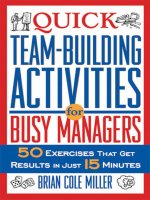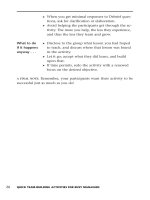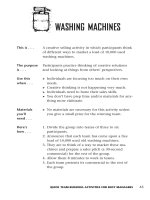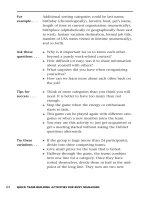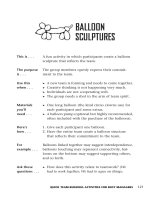Team building and teamwork slideshow (final)
Bạn đang xem bản rút gọn của tài liệu. Xem và tải ngay bản đầy đủ của tài liệu tại đây (1.71 MB, 33 trang )
Rachel Clayberg
Nichole Lynch
Why do companies use teams?
Satisfies the human social need to belong
Two heads are better than one
The whole can be greater than the sum of its
parts
Team members build trust and want to help
each other
Promotes better communication
Multiplies the potential of individual members
Produces positive peer pressure
Provides a framework that will increase the ability of
employees to participate in planning, problem solving, and
decision making.
Makeup
Should be composed of people who are
most likely going to be able to satisfy the
team’s mission effectively.
Commitment to the team and its purpose.
Diversity of skills and personalities.
What are some traits that can contribute to the success of
a team?
Honesty/integrity
Selflessness
Dependability
Enthusiasm
Responsibility
Cooperativeness
Initiative
Patience
Resourcefulness
Punctuality
Tolerance/sensitivity
Perseverance
Roles and Responsibilities
Team Leader
Team Recorder
Team Quality Advisor
Team Member
Team Leader
Official contact between the team and the
rest of the organization
Official record keeper
Serve as a team member
Implement team recommendation
Will be the “coach” for the rest of the team
Coaching
Team leaders should facilitate team
development and continuous improvement
○ Give teams a clearly defined charter
○ Make team development and team building
○
○
○
○
constant activities
Mentor team members
Promote mutual respect between themselves
and team members
Positively promote diversity within the team
Employee empowerment
Team Recorder
Takes minutes during team meetings
Assists the team leader with other types of
correspondence that is generated by the
team
Team Quality Advisor
Focuses on team processes and how decisions
are made
Assists the team leader in breaking down tasks
into component parts and assigning those parts
to other team members
Helps the team leader prepare for meetings
Helps the team members learn to use the
scientific approach
Helps team members convert their
recommendations into presentations that can be
made to upper management
Team Charter
Team Mission
Ground Rules
Team Goals
Mission Statement
Broad, encompasses all activities, progress
can be measured and SIMPLICITY
Ex. The purpose of this team is to reduce
the time between when an order is taken
and when it is filled, while simultaneously
improving the quality of products shipped.
Ground Rules
Agreed upon by the whole team
Describes agreed upon actions and
characteristics of team members
Goals: reaching the mission
Ad Hoc Teams
Permanent Teams
Four-Step Approach
Assess
Plan
Execute
Evaluate
Look for strengths and weaknesses in team members
For a team to be successful, the following characteristics
are needed:
A clear direction that is understood by all
team members
Team players
Understood and accepted accountability
measures
Planning
Based on the results of a needs assessment
Activities should be based on the strengths
and weaknesses of the needs assessment
Execution
Just-in-time
Continuous improvement
Evaluation
Effectiveness can be measured based on
how well weaknesses identified in the needs
assessment were strengthened.
Re-administer the needs assessment
Could result in additional team building
activities
Communication
Structure
Personal
Set a positive example of teamwork and resolving
conflicts at a company level
Identify and address the conflict
Turn into a positive experience
Increase employees communication and
interpersonal skills
Resolution Strategies:
Acknowledge that the conflict exists.
Gain common ground.
Seek to understand all angles.
Attack the issue not each other.
Develop an action plan.



